Parents, teachers, and librarians have come to recognize the sophisticated skills needed to read graphic novels; they are certainly not just for struggling readers. With an increased emphasis on visual literacy, along with the rise of quality fiction and nonfiction titles, the comic art form claims a legitimate place in personal, classroom, and school libraries, and this year has already given us a bevy of quality choices.
Ages 4–8
Duck, Duck, Porcupine! Salina Yoon. 2016. Bloomsbury.
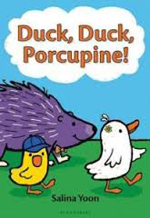 Big Duck fancies herself the authority, but Little Duck’s knowing glances and nonverbal cues as he looks incredulously out of the pages tell perceptive readers that he knows a thing or two. Simple dialogue appears in easily identifiable speech bubbles in three short stories in which three best friends go on a picnic, remember a forgotten birthday, and camp out. The colorful, digitally created illustrations appear on double-page spreads outlined with a thick, black frame, creating a single comic book panel. Duck, Duck, Porcupine is an excellent introduction to the comic art form for the youngest readers.
Big Duck fancies herself the authority, but Little Duck’s knowing glances and nonverbal cues as he looks incredulously out of the pages tell perceptive readers that he knows a thing or two. Simple dialogue appears in easily identifiable speech bubbles in three short stories in which three best friends go on a picnic, remember a forgotten birthday, and camp out. The colorful, digitally created illustrations appear on double-page spreads outlined with a thick, black frame, creating a single comic book panel. Duck, Duck, Porcupine is an excellent introduction to the comic art form for the youngest readers.
—LTP
A Goofy Guide to Penguins. Jean-Luc Coudray. Ill. Philippe Coudray. (TOON Level 1). 2016. Toon/Raw Junior.
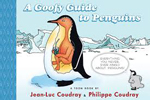 With tongue firmly in cheek, this graphic novel is indeed goofy. Penguin chick narrators pose questions about penguins that are answered via illustration rather than text. Factual questions are interspersed with setup questions for penguin jokes. Observant readers will delight in distinguishing between the two and in deciphering the answers and punch lines. Back matter includes “Amazing But True: 100% Genuine, Real Facts About Penguins” and resources for further reading. For teachers ready to introduce graphic novels into the classroom, this series include Tips for Parents and Teachers: How to Read Comics With Kids.
With tongue firmly in cheek, this graphic novel is indeed goofy. Penguin chick narrators pose questions about penguins that are answered via illustration rather than text. Factual questions are interspersed with setup questions for penguin jokes. Observant readers will delight in distinguishing between the two and in deciphering the answers and punch lines. Back matter includes “Amazing But True: 100% Genuine, Real Facts About Penguins” and resources for further reading. For teachers ready to introduce graphic novels into the classroom, this series include Tips for Parents and Teachers: How to Read Comics With Kids.
—LTP
Narwhal: Unicorn of the Sea! (Narwhal and Jelly #1). Ben Clanton. 2016. Tundra.
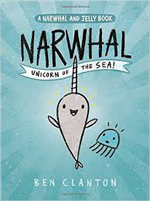 Narwhal, who introduces himself as “Unicorn of the Sea,” makes new friends as he creates his own “pod of awesomeness.” Narwhal’s enthusiasm is contagious. By the end of the book, he has gathered five new friends in his pod, each sporting a horn-like tooth. Narwhal and his jellyfish buddy, Jelly, roam the sea looking for their favorite kinds of adventures. These involve “super awesome” parties, a blank “imagination book” for creating pretend stories, and, of course, waffles. Clanton’s genre-bending graphic novel is organized into five chapters, including one filled with “really fun facts” about narwhals and jellyfish. This first book in a new series about Narwhal and Jelly is rendered in colored pencil and digitally colored. Narwhal fans can look forward to a sequel in 2017: Super Narwhal and Jelly Jolt.
Narwhal, who introduces himself as “Unicorn of the Sea,” makes new friends as he creates his own “pod of awesomeness.” Narwhal’s enthusiasm is contagious. By the end of the book, he has gathered five new friends in his pod, each sporting a horn-like tooth. Narwhal and his jellyfish buddy, Jelly, roam the sea looking for their favorite kinds of adventures. These involve “super awesome” parties, a blank “imagination book” for creating pretend stories, and, of course, waffles. Clanton’s genre-bending graphic novel is organized into five chapters, including one filled with “really fun facts” about narwhals and jellyfish. This first book in a new series about Narwhal and Jelly is rendered in colored pencil and digitally colored. Narwhal fans can look forward to a sequel in 2017: Super Narwhal and Jelly Jolt.
—LDP
The Real Poop on Pigeons! (TOON Level 1). Kevin. McCloskey. 2016. Toon/Raw Juniors.
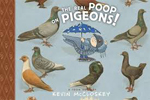 A group of kids dressed as pigeons successfully debunks the opinion that pigeons are “rats with wings” and shows “there’s more to pigeons than poop!” Readers learn that pigeons carried the first airmail, view a diagram of a pigeon’s body, and are introduced to fantastic breeds of pigeons. In an “About the Author,” astute readers discover that the illustrations are on pigeon-blue Fabriano paper (the same paper used by Picasso, who was fascinated with pigeons). Although most pages comprise a single panel with speech bubbles, there are also double-page spreads and two-panel pages perfect for children just beginning to read.
A group of kids dressed as pigeons successfully debunks the opinion that pigeons are “rats with wings” and shows “there’s more to pigeons than poop!” Readers learn that pigeons carried the first airmail, view a diagram of a pigeon’s body, and are introduced to fantastic breeds of pigeons. In an “About the Author,” astute readers discover that the illustrations are on pigeon-blue Fabriano paper (the same paper used by Picasso, who was fascinated with pigeons). Although most pages comprise a single panel with speech bubbles, there are also double-page spreads and two-panel pages perfect for children just beginning to read.
—LTP
Ages 9–11
Alamo All-Stars (Nathan Hale’s Hazardous Tales #6). Nathan Hale. 2016. Amulet/Abrams.
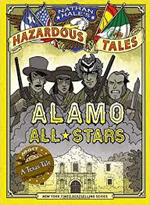 The latest installment in Nathan Hale’s Hazardous Tales series investigates Texas’ fight for independence from Mexico. As in the other historical graphic novels in the series, the story is narrated by Revolutionary War hero, Nathan Hale. Author Hale examines the exploits of famous historical figures during this tumultuous time in Texan history: Jim Bowie, Stephen Austin, and Davy Crockett. Imbued with Hale’s signature brand of humor, this book will both educate and entertain readers. Each book in the series features its own limited color palette; Alamo All-Stars is rendered in a muted olive green.
The latest installment in Nathan Hale’s Hazardous Tales series investigates Texas’ fight for independence from Mexico. As in the other historical graphic novels in the series, the story is narrated by Revolutionary War hero, Nathan Hale. Author Hale examines the exploits of famous historical figures during this tumultuous time in Texan history: Jim Bowie, Stephen Austin, and Davy Crockett. Imbued with Hale’s signature brand of humor, this book will both educate and entertain readers. Each book in the series features its own limited color palette; Alamo All-Stars is rendered in a muted olive green.
—LDP
Bera the One-Headed Troll. Eric Orchard. 2016. First Second/Roaring Brook.
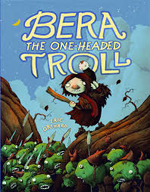 On a tiny island, in a secret cove, lives Bera, a small troll. Bera is the official pumpkin gardener for the troll king. She is content with her role until she finds and rescues a human baby stolen by an evil witch. Bera and her owl friend, Winslowe, set out on a dangerous quest to return the baby to its family. They encounter friends and enemies along the way, and Bera learns that she is destined for a role far more important than that of pumpkin gardener. Orchard used a dip pen and sepia-toned watercolors and gouache to render the art. Readers fascinated by folklore will delight in this dark and heroic fable.
On a tiny island, in a secret cove, lives Bera, a small troll. Bera is the official pumpkin gardener for the troll king. She is content with her role until she finds and rescues a human baby stolen by an evil witch. Bera and her owl friend, Winslowe, set out on a dangerous quest to return the baby to its family. They encounter friends and enemies along the way, and Bera learns that she is destined for a role far more important than that of pumpkin gardener. Orchard used a dip pen and sepia-toned watercolors and gouache to render the art. Readers fascinated by folklore will delight in this dark and heroic fable.
—LDP
Coral Reefs: Cities of the Ocean (Science Comics). Maris Wicks. 2016. First Second/Roaring Brook.
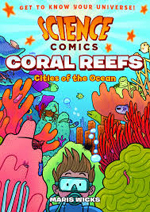 This “get-to-know-your-universe” book begins with an introduction by marine scientist Dr. Randi Rotjan followed by two six-panel pages that zoom in from the universe to a close-up of coral. The panels are clearly delineated, and the color palette reflects life in a coral reef. This graphic novel is jam-packed with facts delivered by the yellow prawn-goby narrator in a conversational tone and with snarky humor that’s sure to delight. Five chapters provide organization. Chapter 3 is a beautifully illustrated field guide to coral and coral reef inhabitants, and Chapter 5 suggests actions even young readers might take to protect the reefs. Back matter includes a glossary, diagrams of coral polyps, a bibliography, and additional resources. Other books in the Science Comics series are Dinosaurs: Fossils and Feathers (2016) and Volcanoes: Fire and Kite (2016).
This “get-to-know-your-universe” book begins with an introduction by marine scientist Dr. Randi Rotjan followed by two six-panel pages that zoom in from the universe to a close-up of coral. The panels are clearly delineated, and the color palette reflects life in a coral reef. This graphic novel is jam-packed with facts delivered by the yellow prawn-goby narrator in a conversational tone and with snarky humor that’s sure to delight. Five chapters provide organization. Chapter 3 is a beautifully illustrated field guide to coral and coral reef inhabitants, and Chapter 5 suggests actions even young readers might take to protect the reefs. Back matter includes a glossary, diagrams of coral polyps, a bibliography, and additional resources. Other books in the Science Comics series are Dinosaurs: Fossils and Feathers (2016) and Volcanoes: Fire and Kite (2016).
—LTP
The Sandwich Thief. André Marois. Trans. Taylor Norman. Ill. Patrick Doyon. 2016. Chronicle.
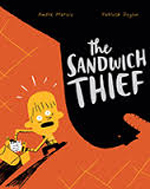 This school mystery is the first installment in a planned series. The graphic illustrations and limited yet vibrant palette create a frenetic tone as Marin tries to trap a lunch-stealing culprit. Is the thief Big Bobby, Poor Marie, Benjamin the Annoying, Mathias the Jealous, Mr. Mars the Janitor, Mr. Geiger the Principal, or Mrs. Ohls the Teacher? Rather than diminish the story, these stock characters are perfect for this melodramatic, madcap adventure. It is of note that Marin’s mother turns to chemistry to help him catch the thief. With a font based on the illustrator’s handwriting and white space that effectively focuses the reader’s attention, The Sandwich Thief will appeal to middle-grade readers, who will relate to Marin’s personality and quirky quest.
This school mystery is the first installment in a planned series. The graphic illustrations and limited yet vibrant palette create a frenetic tone as Marin tries to trap a lunch-stealing culprit. Is the thief Big Bobby, Poor Marie, Benjamin the Annoying, Mathias the Jealous, Mr. Mars the Janitor, Mr. Geiger the Principal, or Mrs. Ohls the Teacher? Rather than diminish the story, these stock characters are perfect for this melodramatic, madcap adventure. It is of note that Marin’s mother turns to chemistry to help him catch the thief. With a font based on the illustrator’s handwriting and white space that effectively focuses the reader’s attention, The Sandwich Thief will appeal to middle-grade readers, who will relate to Marin’s personality and quirky quest.
—LTP
Ages 12–14
The Nameless City (Nameless City #1). Faith Erin Hicks. 2016. First Second/Roaring Brook.
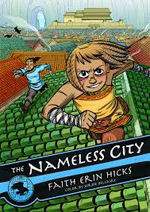 Eisner award-winning author and artist Hicks does not disappoint in this first novel in a planned trilogy. A series of invaders have conquered the city because of its desirable location, and each has renamed the city. Set in an unspecified time and place, but with Tibetan or Chinese feudal overtones, the storyline examines classic themes of power and privilege. The action begins when Kaidu, a Dao who has come to the city to train as a warrior, meets Rat, a street urchin whose parents were killed by the Dao. Kaidu convinces Rat to teach him to run the city’s rooftops in exchange for food, and they develop a tenuous friendship. When Rat overhears men plotting an assassination, her loyalties shift to the Dao, and the action and tension escalate. Hick’s world building is accomplished through vibrant, detailed illustrations and well-written dialogue. The cliff-hanging ending will leave readers eagerly awaiting the next installment.
Eisner award-winning author and artist Hicks does not disappoint in this first novel in a planned trilogy. A series of invaders have conquered the city because of its desirable location, and each has renamed the city. Set in an unspecified time and place, but with Tibetan or Chinese feudal overtones, the storyline examines classic themes of power and privilege. The action begins when Kaidu, a Dao who has come to the city to train as a warrior, meets Rat, a street urchin whose parents were killed by the Dao. Kaidu convinces Rat to teach him to run the city’s rooftops in exchange for food, and they develop a tenuous friendship. When Rat overhears men plotting an assassination, her loyalties shift to the Dao, and the action and tension escalate. Hick’s world building is accomplished through vibrant, detailed illustrations and well-written dialogue. The cliff-hanging ending will leave readers eagerly awaiting the next installment.
—LTP
Snow White: A Graphic Novel. Matt Phelan. 2016. Candlewick.
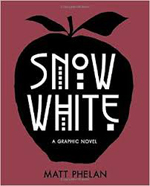 Winner of the Scott O’Dell Award for The Storm in the Barn (2009), acclaimed graphic novelist Matt Phelan delivers a haunting retelling of the classic Snow White fairy tale. The setting is New York City during the time of the roaring ‘20s and the stock market crash in the 1930s. Samantha White’s mother called her Snow, not to be funny, but because “the snow covers everything and makes the entire world beautiful.” Samantha’s father is the King of Wall Street. His wealth catches the attention of the Queen of the Follies, who becomes Samantha’s stepmother following her mother’s death. In Phelan’s version, the enchanted mirror is a stock ticker, which magically delivers threatening messages. When her stepmother learns that Samantha is to inherit the bulk of her father’s fortune, she hires a thug to kill her. The thug, like the classic huntsman, warns Samantha to run and hide. She is rescued and protected by a gang of seven young street urchins. Prince Charming wears the guise of a police detective. Phelan’s muted gray tones and shadows, interspersed with splashes of red, evoke a classic film noir atmosphere.
Winner of the Scott O’Dell Award for The Storm in the Barn (2009), acclaimed graphic novelist Matt Phelan delivers a haunting retelling of the classic Snow White fairy tale. The setting is New York City during the time of the roaring ‘20s and the stock market crash in the 1930s. Samantha White’s mother called her Snow, not to be funny, but because “the snow covers everything and makes the entire world beautiful.” Samantha’s father is the King of Wall Street. His wealth catches the attention of the Queen of the Follies, who becomes Samantha’s stepmother following her mother’s death. In Phelan’s version, the enchanted mirror is a stock ticker, which magically delivers threatening messages. When her stepmother learns that Samantha is to inherit the bulk of her father’s fortune, she hires a thug to kill her. The thug, like the classic huntsman, warns Samantha to run and hide. She is rescued and protected by a gang of seven young street urchins. Prince Charming wears the guise of a police detective. Phelan’s muted gray tones and shadows, interspersed with splashes of red, evoke a classic film noir atmosphere.
—LDP
Ages 15 +
Comics Confidential: Thirteen Graphic Novelists Talk Story, Craft, and Life Outside the Box. Leonard S. Marcus (Ed.). 2016. Candlewick.
 Leonard Marcus, esteemed children’s literature historian, interviews 13 of “the most talented comics creators working today.” Organized in a question-and-answer format, each interview is tailored to that particular storyteller’s unique experience as a prominent graphic novelist. Each novelist also provides a self-portrait, a full-color comic, and a preliminary sketch in response to an open-ended prompt: “the city.” Fans of graphic novels will welcome the opportunity to learn more about their favorite comic artists and to be introduced to others. David Small wrote the foreword, and Marcus provides an introduction outlining a brief history of comics. Back matter includes source notes, art media notes, selected reading (books by the 13 graphic novelists), and an index.
Leonard Marcus, esteemed children’s literature historian, interviews 13 of “the most talented comics creators working today.” Organized in a question-and-answer format, each interview is tailored to that particular storyteller’s unique experience as a prominent graphic novelist. Each novelist also provides a self-portrait, a full-color comic, and a preliminary sketch in response to an open-ended prompt: “the city.” Fans of graphic novels will welcome the opportunity to learn more about their favorite comic artists and to be introduced to others. David Small wrote the foreword, and Marcus provides an introduction outlining a brief history of comics. Back matter includes source notes, art media notes, selected reading (books by the 13 graphic novelists), and an index.
—LDP
How to Talk to Girls at Parties. Neil Gaiman. Ill. Gabriel Bá & Fábio Moon.
2016. Dark Horse.
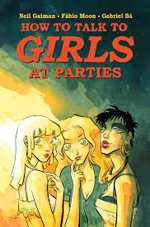 Gabriel Bá and Fábio Moon, twin brothers from Brazil, bring Neil Gaiman’s Locus Award-winning short story to life. Winners of multiple Eisner Awards, the artists use ink and watercolor to create the story’s color-saturated graphic panels. Two teenage boys stumble into a wild party populated with gorgeous girls. As the evening progresses, however, they come to realize that the girls are not quite what they seem; they are not wholly human. The story is infused with Gaiman’s signature sense of the surreal. The film adaptation of this story, directed by John Cameron Mitchell, will be released in theaters in 2017.
Gabriel Bá and Fábio Moon, twin brothers from Brazil, bring Neil Gaiman’s Locus Award-winning short story to life. Winners of multiple Eisner Awards, the artists use ink and watercolor to create the story’s color-saturated graphic panels. Two teenage boys stumble into a wild party populated with gorgeous girls. As the evening progresses, however, they come to realize that the girls are not quite what they seem; they are not wholly human. The story is infused with Gaiman’s signature sense of the surreal. The film adaptation of this story, directed by John Cameron Mitchell, will be released in theaters in 2017.
—LDP
Something New: Tales From a Makeshift Bride. Lucy Knisley. 2016. First Second/Roaring Brook.
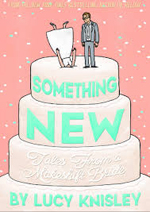 From the best-selling author of Relish: My Life in the Kitchen (2013) comes a new graphic memoir. While Relish explored Lucy Knisley’s passion for the culinary arts, in Something New, she applies her creative spirit to cooking up a wedding. Cartoonist Knisley delivers an honest portrayal of the drama involved with trying to manage the minutia of wedding planning. With her signature wit and colorful cartoons, Knisley documents her unique experience: “a wedding story about how nuts weddings are, but, at the same time, how great.” Her captivating graphic art is interspersed with personal photographs.
From the best-selling author of Relish: My Life in the Kitchen (2013) comes a new graphic memoir. While Relish explored Lucy Knisley’s passion for the culinary arts, in Something New, she applies her creative spirit to cooking up a wedding. Cartoonist Knisley delivers an honest portrayal of the drama involved with trying to manage the minutia of wedding planning. With her signature wit and colorful cartoons, Knisley documents her unique experience: “a wedding story about how nuts weddings are, but, at the same time, how great.” Her captivating graphic art is interspersed with personal photographs.
—LDP
Linda T. Parsons is an associate professor in the Department of Teaching and Learning on the Marion Campus of The Ohio State University where she specializes in middle childhood literacy and young adult literature. Lisa D. Patrick is a literacy coach trainer at The Ohio State University’s Literacy Collaborative where she specializes in children’s literature and early literacy.
These reviews are submitted by members of the International Literacy Association's Children's Literature and Reading Special Interest Group (CL/R SIG) and are published weekly on Literacy Daily.